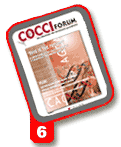COCCI FAQsSchering-Plough Animal Health’s technical service team answers questions about managing coccidiosisQ.COCCIDIOSIS VACCINES FOR POULTRY HAVE BEEN AROUND SINCE THE 1950S. WHY ARE WE HEARING ABOUT THEM MORE NOW?
A. Several reasons. In a nutshell:
Traditional, in-feed anticoccidials such
as salinomycin and other ionophores
have been so widely used that resistance
to them is developing, resulting in
coccidiosis outbreaks. Furthermore,
consumer demand has increased for
birds raised with fewer drugs in the
food chain. Immunization offers a more
natural approach for control of coccidiosis
in poultry. In recent years, new
methods of administering coccidiosis
vaccination have been developed to
ensure better uniformity and efficacy
than in the past.
A. No. Immunity against one particular
coccidial species is specific and will
not protect against another coccidial
species. Consequently, vaccines each
contain several species of coccidia
known to be a problem in the targeted
bird population. That’s how broad protection
against coccidiosis is achieved
with vaccines.
A. It’s possible if birds are accidentally
exposed to infective oocysts. But
the development of immunity also
depends on how often and how long
birds are exposed and they may not be
exposed to all the various species of
coccidia that could pose a problem
down the road. The development of
natural immunity also may not be realized
until at least 6 weeks of age.
A. No. Vaccination enables birds to
naturally develop lifelong immunity
against coccidia, which helps prevent
the development of coccidiosis. No
resistance develops. In contrast, in-feed
anticoccidials control the development
of coccidiosis by minimizing the existing
population of coccidia. This is an
entirely different approach to coccidiosis
control that can and has resulted in
the development of resistance to anticoccidials,
particularly those used over
a long period of time.
A. It can, as long as the vaccine used
provides live, drug-sensitive coccidia.
Research conducted by Dr. Harry D.
Danforth, PhD, a USDA research
microbiologist, has demonstrated that
vaccinating with Coccivac-B — a product
containing live, drug-sensitive coccidia
— changes the sensitivity of coccidia
on the floor of grow-out houses.
More specifically, studies by Danforth
showed that using this type of vaccine
helped restore sensitivity to the ionophore
salinomycin.
A. Not if it’s a high-quality product
made by a reputable manufacturer.
Coccivac-B, for example, is produced
according to strict quality-control
methods and undergoes multiple tests
to ensure purity. Schering-Plough
Animal Health tests the product during
several stages of production to make
sure that final batches are free of bacteria,
fungi and mycoplasma, even
though mycoplasma testing for coccidiosis
vaccines is not required by the
USDA.
A. Chicks are attracted to reds and
other primary colors, so the red dye in
a coccidiosis vaccine actually encourages
preening by chicks in the hatchery.
The ingestion of oocysts occurs
immediately following vaccination. The
lingering presence of the dye indicates
that the birds have in fact been properly
vaccinated, but does not mean that
any vaccine has gone unused. |




 © 2000 - 2021. Global Ag MediaNinguna parte de este sitio puede ser reproducida sin previa autorización.
© 2000 - 2021. Global Ag MediaNinguna parte de este sitio puede ser reproducida sin previa autorización.